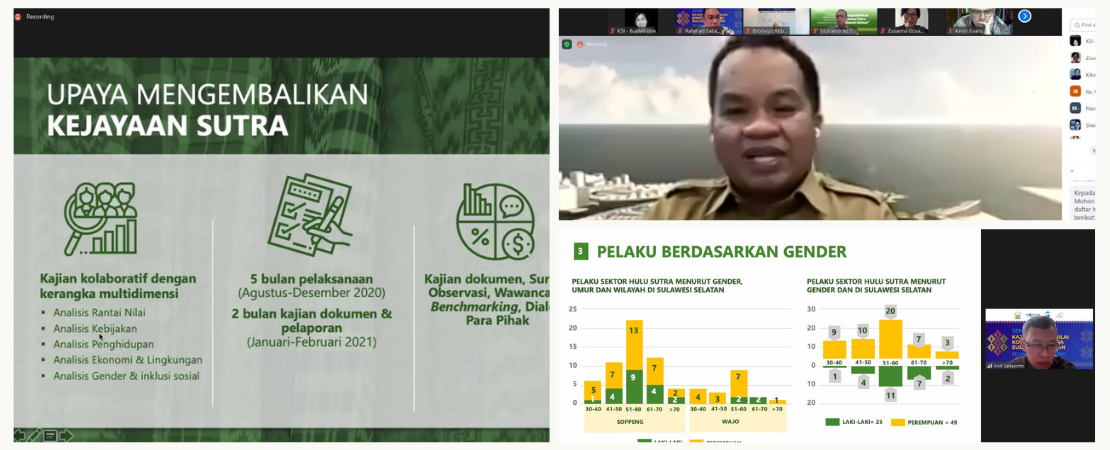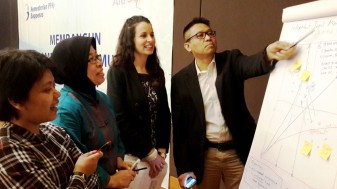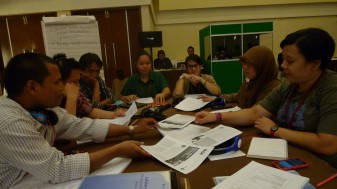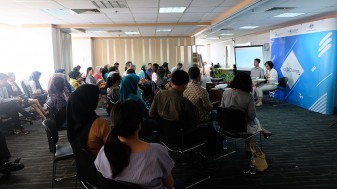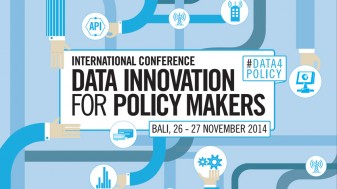Silk was once a leading commodity in South Sulawesi Province before its production started to continuously decline. A study of its value chain was therefore conducted with the hope to promote the development of evidence-based policies that can restore the glory of silk and bring welfare to the province.
It was the topic discussed in "Seminar on the Results of Silk Commodity Value Chain Study: Restoring the Glory of South Sulawesi’s Silk,” which was held online on Tuesday (9/2). This event was facilitated by BaKTI Foundation in collaboration with the Development Planning Agency for Research and Development (Bapelitbangda) of South Sulawesi Province and Payo-Payo Farmers' Community School with support from Knowledge Sector Initiative (KSI). This seminar aimed to present the results of a study of silk value chain in three districts in South Sulawesi, namely Enrekang, Soppeng and Wajo. Apart from the research team who presented the results of their study, a number of discussants were also invited to give inputs.
The value chain study which began in August 2020 was part of an evidence-based policy-making pilot program implemented by Bapelitbangda Sulsel and BaKTI Foundation with the support of KSI. "Silk has become a strategic commodity because its value chain is long, involving many actors and has the potential to restore the regional economy in the post Covid-19 pandemic era," said the Director of BaKTI Foundation, Muhammad Yusran Laitupa.
The collaborative study carried out by Bapelitbangda Sulsel and BaKTI Foundation along with other knowledge actors to demonstrate knowledge-based policy making was appreciated by the Australian Consul General in Makassar, Bronwyn Robbins. According to her, the application of the triple helix approach (involving three actors, namely government, academics and non-governmental organizations) in this study would capture a broader perspective highly necessary to promote the development of evidence-based policies. As a result, the silk industry could start its recovery which in turn will play an important role in economic recovery in the post Covid-19 pandemic era.
The head of the research team, Andi Sadapotto explained that the study which lasted for five months used a multi-disciplinary framework. All aspects including the value chain, policies, livelihoods, economy and environment, gender and social inclusion were included in the framework. According to him, the silk industry started to grow in South Sulawesi in the 1950s and developed rapidly in rural areas. In the 1970s, South Sulawesi produced 140 tons of silk yarn per annum. However, starting from the 1980s, silk production continued to decline. Currently, the production of silk yarn in South Sulawesi is only 2.5 tons per year.
The research team found that the causes of the decline in silk production were in the upstream, production and manufacturing sectors, as well as downstream sectors. In the upstream sector, obstacles include the decline in the number of mulberry farmers and silkworm cultivators due to land conversion and dependence on imports of silkworm eggs. On the other hand, policies to spur production have no clear direction and research related to the upstream silk sector is run sporadically.
In the production and manufacturing sectors, problems encountered include the low quality of cocoons, limited spinning equipment, lack of local yarn supply, and spinning business actors who have gone out of business. Independent weavers find it difficult to survive because of the low wages. For each piece of silk sarong they work on for three days, they receive Rp. 30,000. The workforce in this sector is dominated by women with low levels of education. As for the downstream sector, this study found that the potential of the local silk market was actually promising because the life cycle of the Bugis Makassar people was very connected to silk. Starting from the ritual of a baby being born to traditional and social events, people must wear silk cloth. However, consumers cannot tell the difference between real and blended silk so they prefer mixed fabrics which are more affordable.
A research team member, Lusia Palulungan said that to restore the glory of South Sulawesi silk, various efforts need to be made in the upstream, manufacturing and production and downstream sectors according to the findings of existing problems. In the upstream sector, for example, there needs to be an improvement in the production of silkworm eggs, an improvement in the early detection of disease systems, an improvement in infrastructure and human resources, organizing farmers, increasing the capacity of farmer facilitators to be gender sensitive and so on.
In the manufacturing and production sectors, it is necessary to establish a management unit for automatic spinning equipment provided by the government. Apart from that, training for weavers, forming groups of weavers, opening access to tools and capital for weavers, monitoring the rights of weavers and others are also necessary. Meanwhile in the downstream sector, there needs to be a joint regulation with the governor and regent regarding the labeling of silk production, promotional support in various ways including the policy of wearing silk on certain days, improving the silk product certification system and so on. All of these efforts must be supported by cross-sectoral policies.
One of the discussants, Sumedi Andono Mulyo from the National Development Planning Agency (Bappenas) expressed his appreciation to the results of this study. The policy recommendations produced through this study were quite detailed. According to him, this study proved that in general, the first-level business actors such as the farmers, craftsmen and fishermen did not get the accumulated value added of products. Therefore, to build an inclusive regional economy, added value must be reached by the farmers/ fishermen/craftsmen as well as traders. "From this study, we know where the added value is and what should be done, for example related to poverty alleviation efforts," he said.
This seminar constituted a means for the Study Team to collect input and feedback on the results that were presented in order to complete the study report. Representatives of various provincial and district offices, researchers and observers who shared interests in South Sulawesi silk, and representatives of several ministries also attended and gave comments at the discussion session. The points presented provided valuable inputs that strengthened the report and policy recommendations of this study. Furthermore, the South Sulawesi Bappelitbangda, in collaboration with BaKTI Foundation, would support effort to transform these recommendations into a provincial government policy to promote silk industry in the province.
KSI supports the pilot program that demonstrates an evidence-based policy-making cycle, in which a regional priority policy agenda is supported through an applied study that will provide the basis for policies. The silk value chain study in South Sulawesi was a part of the pilot program. This support is provided by KSI to promote development of policies that make better use of research results, data and analysis at the local level. The model and approach implemented will be documented to facilitate replication by the Regional Government of South Sulawesi and other regions in Indonesia.

